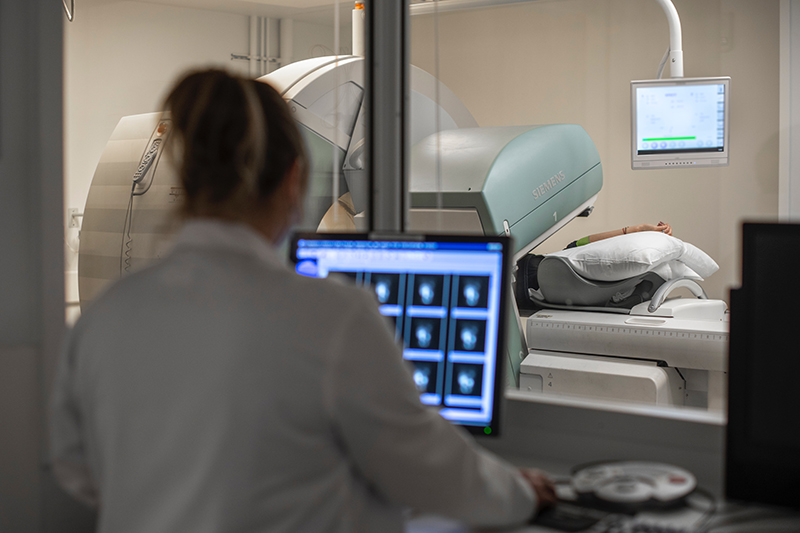A nuclear stress test shows how well your blood flows to your heart and if any blockages exist in your heart’s arteries. This helps diagnose coronary artery disease and show whether treatments are working. A provider injects a small amount of radioactive tracer into your blood. A special camera takes pictures of blood flow in and around your heart.
Advertisement
Cleveland Clinic is a non-profit academic medical center. Advertising on our site helps support our mission. We do not endorse non-Cleveland Clinic products or services. Policy
A nuclear stress test is a heart imaging tool that helps healthcare providers see blood flow in your heart muscle. They use a special camera to pick up an injected radioactive tracer in your heart muscle. Poor blood flow in images helps providers diagnose heart disease.
Advertisement
Cleveland Clinic is a non-profit academic medical center. Advertising on our site helps support our mission. We do not endorse non-Cleveland Clinic products or services. Policy
This test shows how well blood flows to your heart and if any arteries have blockages. Cardiologists (heart doctors) use nuclear stress tests to diagnose and monitor coronary artery disease (CAD). This disease involves clogged or blocked blood vessels.
The test can also tell your healthcare provider if your heart muscle is pumping well and if you have heart damage from a heart attack.
The test has other names, like:
A healthcare provider can use two different imaging methods for a nuclear cardiac stress test: PET or SPECT. Sometimes, a stress test requires you to exercise to simulate stress. Other times, you may receive medication to stress your heart.
With an exercise stress test, you walk on a treadmill or ride on a stationary bike to increase blood flow to your heart and reach a target heart rate.
If you can’t exercise, you may receive medication to increase blood flow and stress your heart. This is a pharmacological stress test.
Healthcare providers may use a nuclear stress test if you have symptoms of chest pain or angina, if they want to test the fitness of your heart before a procedure, or to see if you may have areas of scarring or ischemia (lack of blood flow) in your heart.
Advertisement

The test detects the radioactive tracer and uses it to create pictures. Heart muscle that doesn’t get enough blood flow looks different from healthy muscle in images. This is because it absorbs the tracer differently than healthy tissue does.
Your healthcare provider will tell you how to prepare for the test. The instructions may include:
A technician or another provider usually performs this nuclear stress test procedure in a hospital or clinic. If you can’t exercise, a provider can inject medicine into your arm. The drug stimulates your heart and increases blood flow as if you were physically active.
A healthcare provider will:
This test exposes you to a small amount of radiation. These low-dose radiation tracers are considered very safe. Some people might be allergic to the tracer or have some flushing, nausea or shortness of breath.
Advertisement
Rarely, people can have side effects, like:
A nuclear stress test may be harmful to a fetus or nursing baby. Ask your provider if you can wait until after delivery or prepare milk in advance. You shouldn’t have a nuclear cardiac stress test if you have certain problems that are severe or not managed, like:
Your healthcare provider will tell you what to do after the test. People usually can go back to normal activities right away. After the test, you may feel tired. That should go away with time and rest.
Results of a nuclear stress test may take a few days. A heart expert (cardiologist) or radiologist (imaging expert) must review the images and interpret the results.
Normal results at rest and under stress mean your blood flow is good.
Poor blood flow at rest and under stress (or only under stress) is abnormal. It could mean you have a blockage in an artery that brings blood to your heart.
If the test doesn’t pick up the tracer, that could mean you have heart muscle damage from a heart attack.
If you have abnormal results, your healthcare provider may want to do a coronary angiogram. This test involves putting dye into your heart’s arteries to see how well it gets through.
Advertisement
If a nuclear stress test shows that you have poor blood flow because of artery blockages, your healthcare provider will want to keep CAD from getting worse. They’ll want to prevent you from having a heart attack. To do this, you may need to:
Contact your provider if you have mild side effects (like nausea or shortness of breath) from the test. Seek medical care right away if you have chest pain or other heart attack symptoms, or if you feel like your heart rhythm is off.
You may have some concerns about needing a nuclear cardiac stress test. And you may worry about what a healthcare provider will find. But the sooner you get the test done, the sooner you can get treatment if you need it. Be sure to tell your provider about any medications you take, and ask any questions you have about the test.
Advertisement
When your heart needs some help, the cardiology experts at Cleveland Clinic are here for you. We diagnose and treat the full spectrum of cardiovascular diseases.

Last reviewed on 09/23/2025.
Learn more about the Health Library and our editorial process.